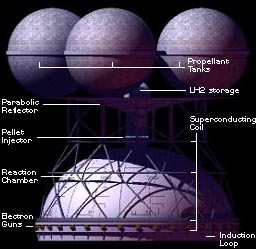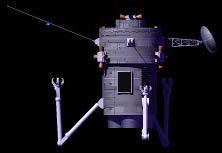Project Daedalus

Figure 1. Comparison of the Daedalus spacecraft and Saturn V Moon rocket. Credit/copyright: Adrian Mann.

Figure 2. Daedalus probe arriving at Barnard's Star. Credit/copyright: Adrian Mann.

Figure 3. Daedalus first stage. Credit/copyright: Adrian Mann.

Figure 4. Daedalus warden. Credit/copyright: Adrian Mann.
Project Daedalus was one of the first detailed design studies of an interstellar spacecraft.1 Conducted between 1973 and 1977 by a group of a 11 scientists and engineers belonging to the British Interplanetary Society, led by former Rolls Royce rocket engineer Alan Bond, it demonstrated that rapid, unmanned travel to the stars is a practical possibility. Certain guidelines were adopted: the Daedalus spacecraft had to use current or near-future technology, be able to reach its destination within a human lifetime, and be flexible enough in its design that it could be sent to any of a number of target stars. These guidelines ensured that the spacecraft would be practical, that those who worked on the project might live to see it achieve its goals, and that several stars could be investigated using the same type of vehicle.
The selected target was Barnard's Star, a red dwarf lying 5.9 light-years from the Sun. Although the Alpha Centauri system is closer, evidence available at the time (now considered unreliable) suggested that Barnard's Star might be orbited by at least one planet. To reach Barnard's Star in 50 years (the flight time allotted in the study), a spacecraft would need to cruise at about 12% of the speed of light, or 36,000 km/s. This being far beyond the scope of a chemical rocket, the Daedalus team had to consider less conventional alternatives. The design they chose was a form of nuclear-pulse rocket, a propulsion system that had already been investigated during Project Orion. However, whereas Orion would have employed nuclear fission, the Daedalus engineers opted to power their starship by nuclear fusion – in particular, by a highly-efficient technique known as internal confinement fusion. Small pellets, containing a mixture of deuterium and helium-3, would be bombarded, one at a time, in the spacecraft's combustion chamber by electron beams and thereby caused to explode like miniature thermonuclear bombs. A powerful magnetic field would both confine the explosions and channel the resulting high-speed plasma out of the rear of the spacecraft to provide thrust. By detonating 250 pellets a second, and utilizing a two-stage approach, the desired cruising speed could be reached during an acceleration phase lasting four years.
Daedalus would be constructed in Earth orbit and have an initial mass of 54,000 tons, including 50,000 tons of fuel and 500 tons of scientific payload. The first stage (shown left) would be fired for two years, taking the spacecraft to 7.1% of light speed, before being shut down and jettisoned. Then the second stage would fire for 1.8 years before being shut down to begin the 46-year cruise to Barnard's Star. Since the design made no provision for deceleration upon arrival, Daedalus would carry 18 autonomous probes, equipped with artificial intelligence, to investigate the star and its environs. The 40-meter diameter engine of the second stage would double as a communications dish. On top of the second stage would be a payload bay containing the probes, two 5-meter optical telescopes, and two 20-m radio telescopes. Robot wardens (shown below) would be able to make in-flight repairs. A 50-ton disk of beryllium, 7 millimeters thick, would protect the payload bay from collisions with dust and meteoroids on the interstellar phase during the flight, while an artificially-generated cloud of particles some 200 kilometers ahead of the vehicle would help disperse larger particles as the probe plunged into the planetary system of the target star. En route, Daedalus would make measurements of the interstellar medium. Some 25 years after launch, its onboard telescopes would begin examining the area around Barnard's Star to learn more about any accompanying planets. The information thus gathered would be fed to the computers of the probes, which would be deployed between 7.2 and 1.8 years before the main craft entered the target system. Powered by nuclear-ion drives and carrying cameras, spectrometers, and other sensory equipment, the probes would fly quickly past any planets looking especially for any signs of life or conditions favorable for biology.
Reference
1. Bond, A., Martin, A. R., Buckland, R. A., Grant, T. J., Lawton, A. T., et al. "Project Daedalus." Journal of the British Interplanetary Society, 31 (Supplement, 1978).


